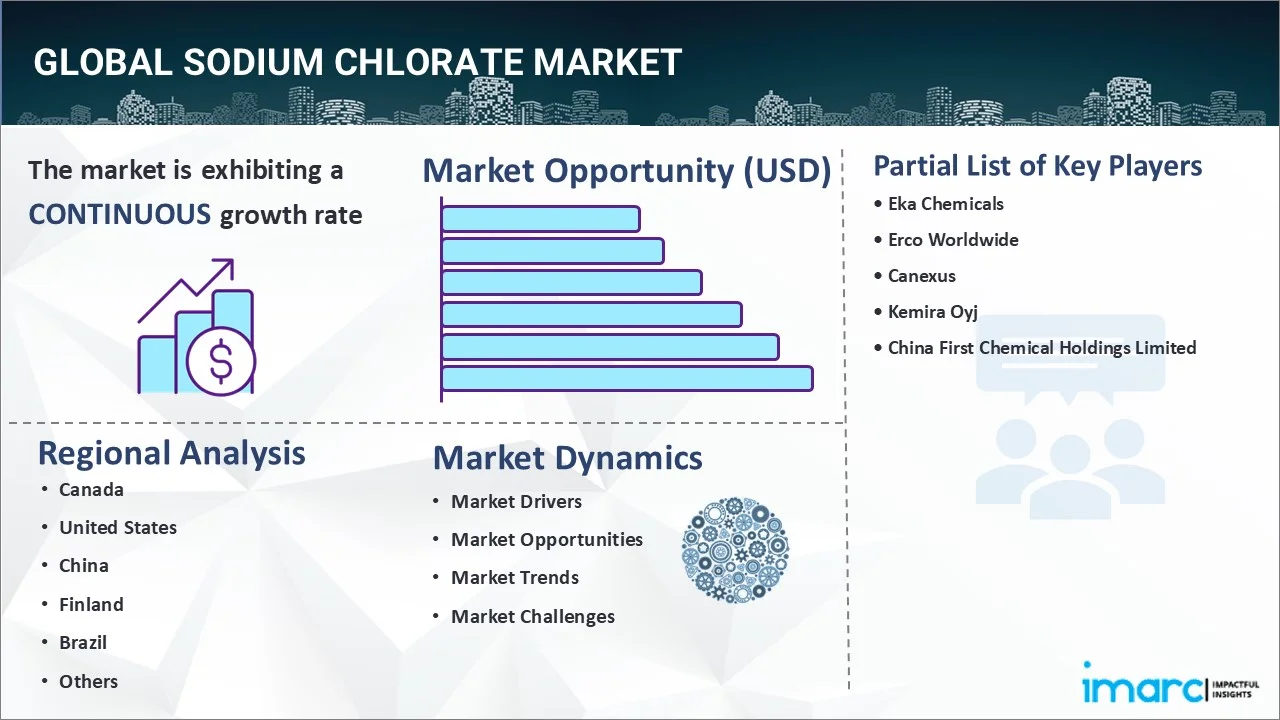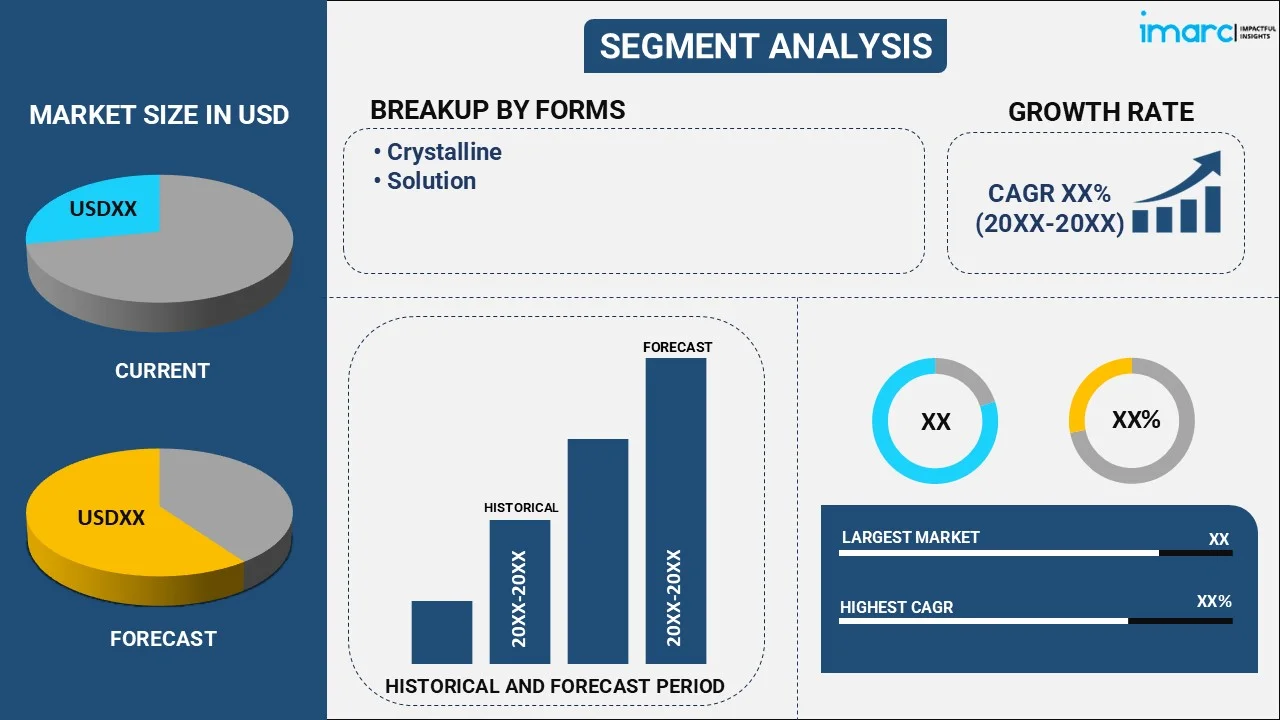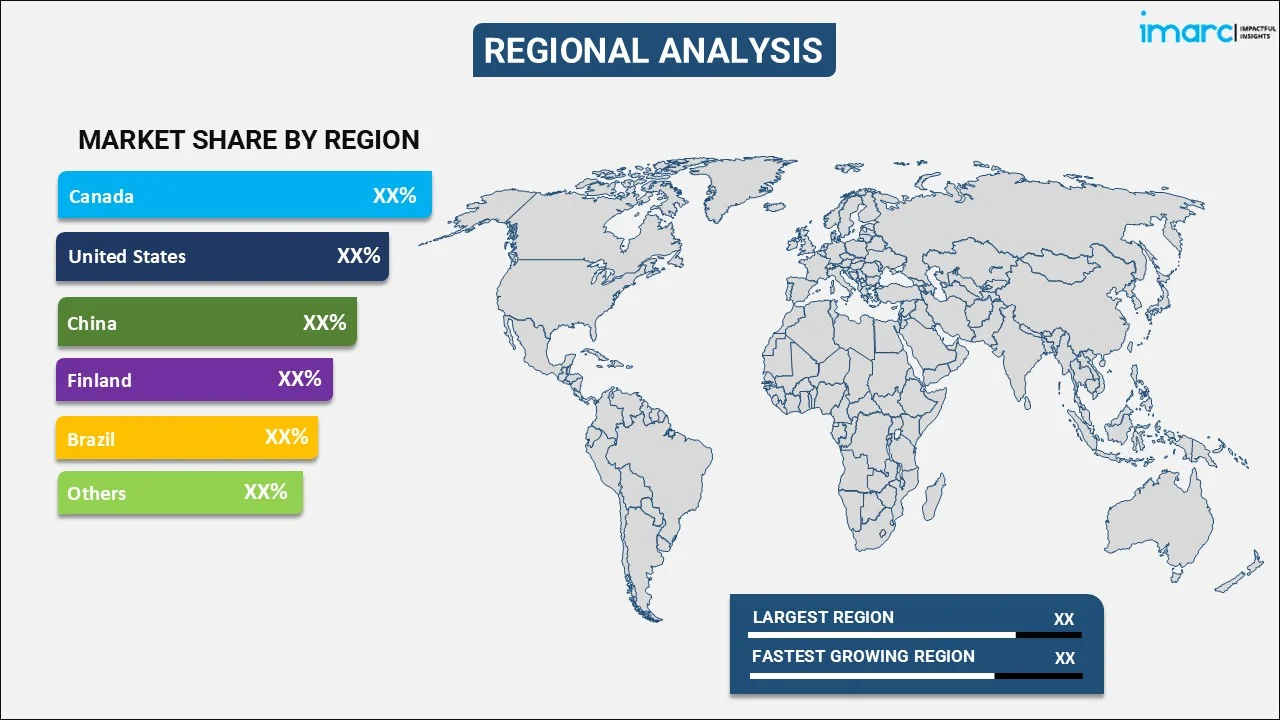
Sodium Chlorate Market Report by Form (Crystalline, Solution), Application (Pulp and Bleaching Industry, Chlorates of Other Metals, Leather Tanning, Dyes, and Others), and Region 2025-2033
Market Overview:
The global sodium chlorate market size reached USD 3.5 Billion in 2024. Looking forward, IMARC Group expects the market to reach USD 5.2 Billion by 2033, exhibiting a growth rate (CAGR) of 4.6% during 2025-2033. The increasing demand for sodium chlorate from industries including textiles, pulp and paper, agriculture, and construction is significantly driving the market growth.
|
Report Attribute
|
Key Statistics
|
|---|---|
|
Base Year
|
2024
|
|
Forecast Years
|
2025-2033
|
|
Historical Years
|
2019-2024
|
|
Market Size in 2024
|
USD 3.5 Billion |
|
Market Forecast in 2033
|
USD 5.2 Billion |
| Market Growth Rate 2025-2033 | 4.6% |
Sodium chlorate (NaClO3) is an inorganic chemical compound manufactured by the electrolysis of brine (NaCl). A powerful oxidizing agent, sodium chlorate is an odorless, pale-yellow crystalline solid and readily dissolves in water. It is inflammable in nature in pure form and acts as an extreme combustion accelerant in the presence of flammable materials during decomposition. Currently, sodium chlorate is widely used in the preparation of chlorine dioxide which is employed as a bleaching agent in the manufacturing of bleached pulp.

Global Sodium Chlorate Market Drivers:
- The paper and pulp industry is one of the largest markets for sodium chlorate where it is used for on-site generation of chlorine dioxide. It is the key bleaching agent for elemental chlorine free (ECF) chemical pulping process and is extensively used in emerging markets like India and China.
- On account of its oxidizing properties, sodium chlorate is increasingly being used for several applications such as tanning and finishing leather, and manufacturing of dyes. The mounting demand for sodium chlorate in these industries is expected to bolster the sodium chlorate market size in the upcoming years.
- As sodium chlorate is phytotoxic to all green plants, it is now being utilized as a non-selective herbicide to control the growth of a variety of plants including morning glory, creeping thistle, johnsongrass, bamboo, Ragwort, and St John's wort. It is mainly used for vegetation control on roadsides, fenceways, etc. and on non-crop land for spot treatment.
- Sodium chloride and water are the two major feedstocks required for the manufacturing of sodium chlorate. These raw materials are low in cost and abundant in nature, due to which sodium chlorate is affordable. This, coupled with ease of storage, makes it ideal for a variety of applications.
Key Market Segmentation:
IMARC Group provides an analysis of the key trends in each sub-segment of the global sodium chlorate market report, along with forecasts at the global and country level from 2025-2033. Our report has categorized the market based on form and application.
Breakup by Form:

- Crystalline
- Solution
On the basis of form, the sodium chlorate market is bifurcated as crystalline and solution. Amongst these, crystalline sodium chlorate accounts for the majority of the market share as it is employed in a range of industries like bleach and explosives.
Breakup by Application:
- Pulp and Bleaching Industry
- Chlorates of Other Metals
- Leather Tanning
- Dyes
- Others
Based on application, the pulp and bleaching industry accounted for the largest sodium chlorate market share, owing to its growing demand in the textile industry. Other application segments include chlorates of other metals, leather tanning, dyes and others.
Regional Insights:

- Canada
- United States
- China
- Finland
- Brazil
- Others
On a geographical front, Canada enjoys the leading position in the global sodium chlorate market as the country has the largest pulp and paper industry which is a mainstay of the country’s economy. While Canada leads the market in terms of production, the United States also represents a noteworthy market for sodium chlorate. The country's diverse industrial landscape, including chemicals, textiles, and mining, contributes to a steady demand for sodium chlorate. Overall, the North American region possesses a well-established infrastructure, advanced manufacturing capabilities, and a robust focus on sustainable practices within the chemical industry. These trends are projected to further propel the product demand in the region.
Competitive Landscape:
The market is fragmented in nature with the presence of a large number of international and regional manufacturers who compete in terms of prices and quality. The major players are trying to increase their presence in new markets by creating alliances or acquiring regional or other small players. Some of the leading players operating in the market are:
- Eka Chemicals
- Erco Worldwide
- Canexus
- Kemira Oyj
- China First Chemical Holdings Limited
The report provides a comprehensive insight into the sodium chlorate market outlook, including its market breakup by region, market breakup by end-use, SWOT analysis, Porter’s five forces analysis, value chain analysis, import and export trends, key players and market outlook. The report also gives an in-sight into the manufacturing process of sodium chlorate covering key success and risk factors for manufacturers, detailed process flow, the chemical reactions involved, raw materials requirements, etc. This report is a must-read for entrepreneurs, investors, researchers, consultants, business strategists, and all those who have any kind of stake or are planning to foray into the sodium chlorate industry in any manner.
Report Coverage:
| Report Features | Details |
|---|---|
| Base Year of the Analysis | 2024 |
| Historical Period | 2019-2024 |
| Forecast Period | 2025-2033 |
| Units | Million Tons, Billion USD |
| Segment Coverage | Form, Application, Country |
| Countries Covered | Canada, United States, China, Finland, Brazil, Others |
| Companies Covered | Eka Chemicals, Erco Worldwide, Canexus, Kemira Oyj, China First Chemical Holdings Limited |
| Customization Scope | 10% Free Customization |
| Post-Sale Analyst Support | 10-12 Weeks |
| Delivery Format | PDF and Excel through Email (We can also provide the editable version of the report in PPT/Word format on special request) |
Key Questions Answered in This Report
The global sodium chlorate market reached a value of USD 3.5 Billion in 2024.
According to the estimates by IMARC Group, the global sodium chlorate market is expected to grow at a CAGR of 4.6% during 2025-2033.
At present, due to the rising environmental concerns, there is an increase in the demand for elemental chlorine-free (ECF) paper products. Moreover, sodium chlorate is gaining popularity as a non-selective herbicide for vegetation control on roadsides and fence ways.
Lockdowns announced by governments of several countries on account of the sudden spread of the coronavirus disease (COVID-19) have disrupted supply chains and halted the manufacturing units of various industry verticals. Consequently, the market is currently experiencing negative growth due to the pandemic.
Significant growth in the pulp and paper industry represents one of the key factors creating a positive outlook for the market as it is used as a bleaching agent in the production of elemental chlorine-free (ECF) paper products.
Based on the form, the market has been bifurcated into crystalline and solution sodium chlorate.
On the basis of the application, the market has been segregated into pulp and bleaching industry, chlorates of other metals, leather tanning, dyes and others.
Region-wise, the market has been segmented into the United States, Canada, China, Finland, Brazil and others.
Need more help?
- Speak to our experienced analysts for insights on the current market scenarios.
- Include additional segments and countries to customize the report as per your requirement.
- Gain an unparalleled competitive advantage in your domain by understanding how to utilize the report and positively impacting your operations and revenue.
- For further assistance, please connect with our analysts.
 Inquire Before Buying
Inquire Before Buying
 Speak to an Analyst
Speak to an Analyst
 Request Brochure
Request Brochure
 Request Customization
Request Customization




.webp)




.webp)












